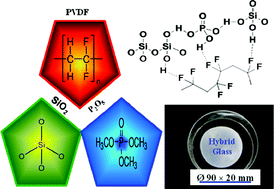Effects of SiO2 and P2O5 on structural, thermal and conductivity properties of inorganic materials doped with PVDF
Abstract
Poly(vinylidene fluoride) (PVDF) doped hybrid glass membranes were prepared with various concentrations of

* Corresponding authors
a
Research Core for Interdisciplinary Sciences (RCIS), Okayama University, Tsushima-Naka Kita-Ku, Okayama, Japan
E-mail:
umthan09@cc.okayama-u.ac.jp
Fax: +81 86 251 8705
Tel: +81 86 251 8706
b Department of Materials Science and Engineering, Nagoya Institute of Technology, Showa, Nagoya, Japan
Poly(vinylidene fluoride) (PVDF) doped hybrid glass membranes were prepared with various concentrations of

 Please wait while we load your content...
Something went wrong. Try again?
Please wait while we load your content...
Something went wrong. Try again?
U. Thanganathan and M. Nogami, RSC Adv., 2012, 2, 9596 DOI: 10.1039/C2RA21520A
To request permission to reproduce material from this article, please go to the Copyright Clearance Center request page.
If you are an author contributing to an RSC publication, you do not need to request permission provided correct acknowledgement is given.
If you are the author of this article, you do not need to request permission to reproduce figures and diagrams provided correct acknowledgement is given. If you want to reproduce the whole article in a third-party publication (excluding your thesis/dissertation for which permission is not required) please go to the Copyright Clearance Center request page.
Read more about how to correctly acknowledge RSC content.
 Fetching data from CrossRef.
Fetching data from CrossRef.
This may take some time to load.
Loading related content
